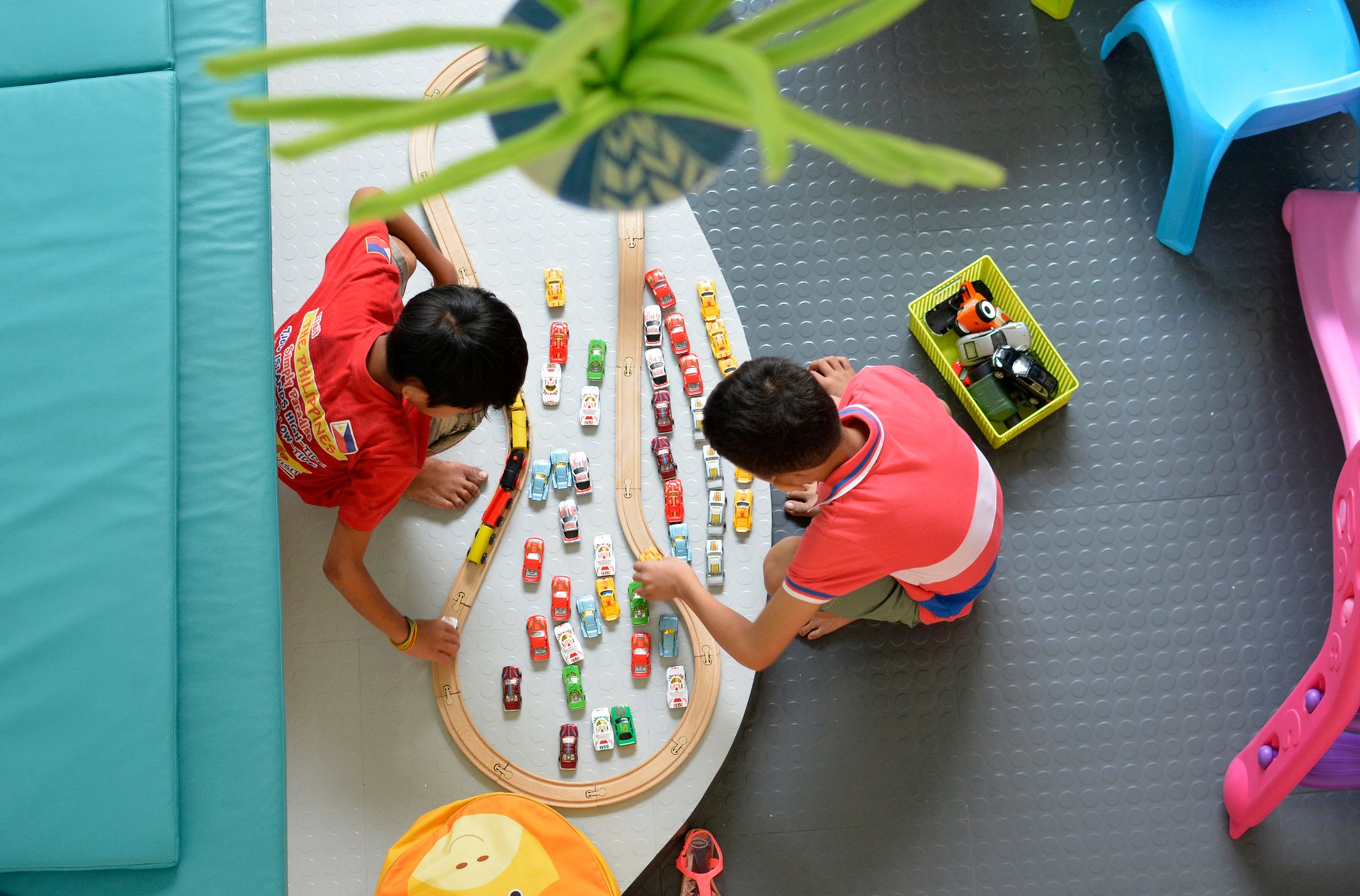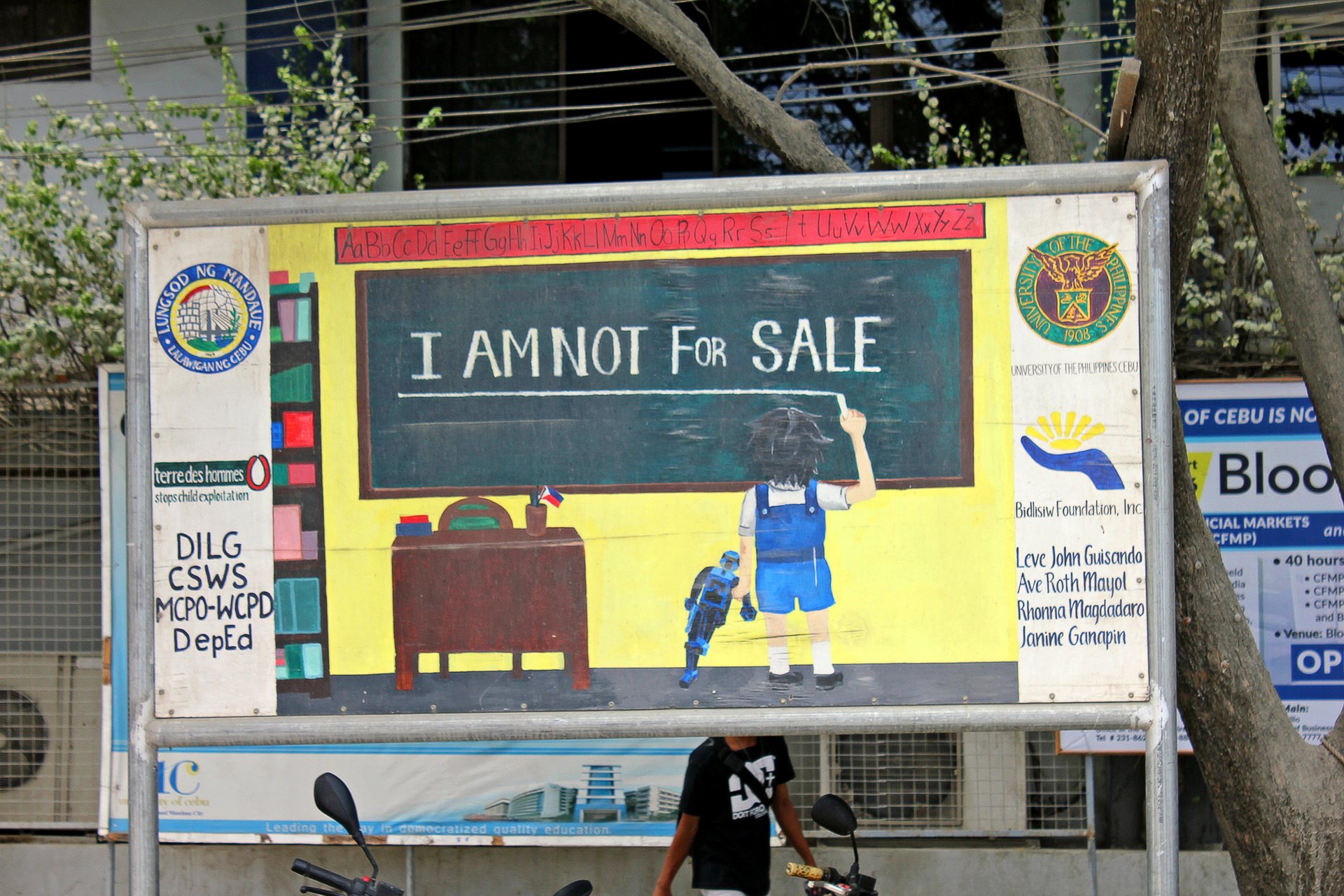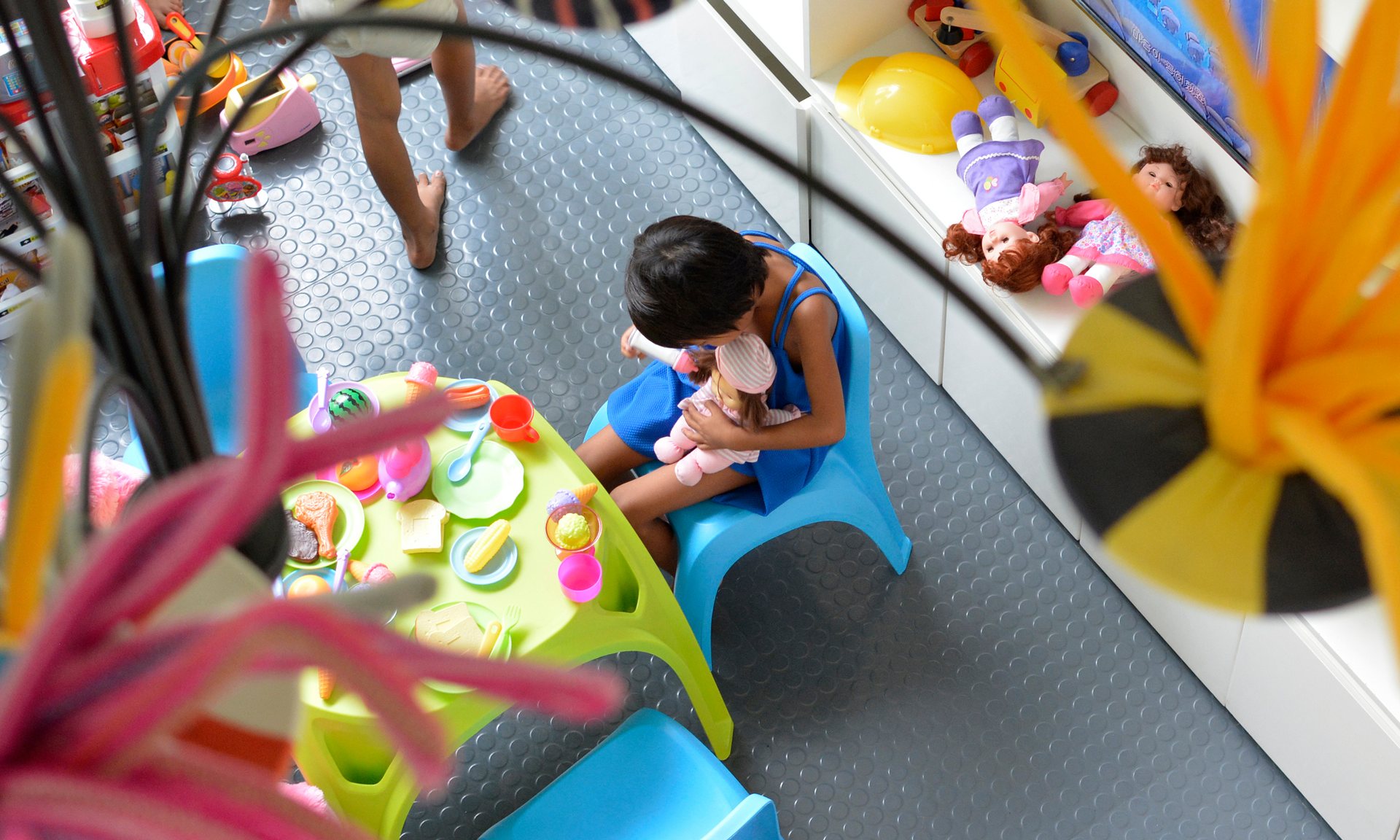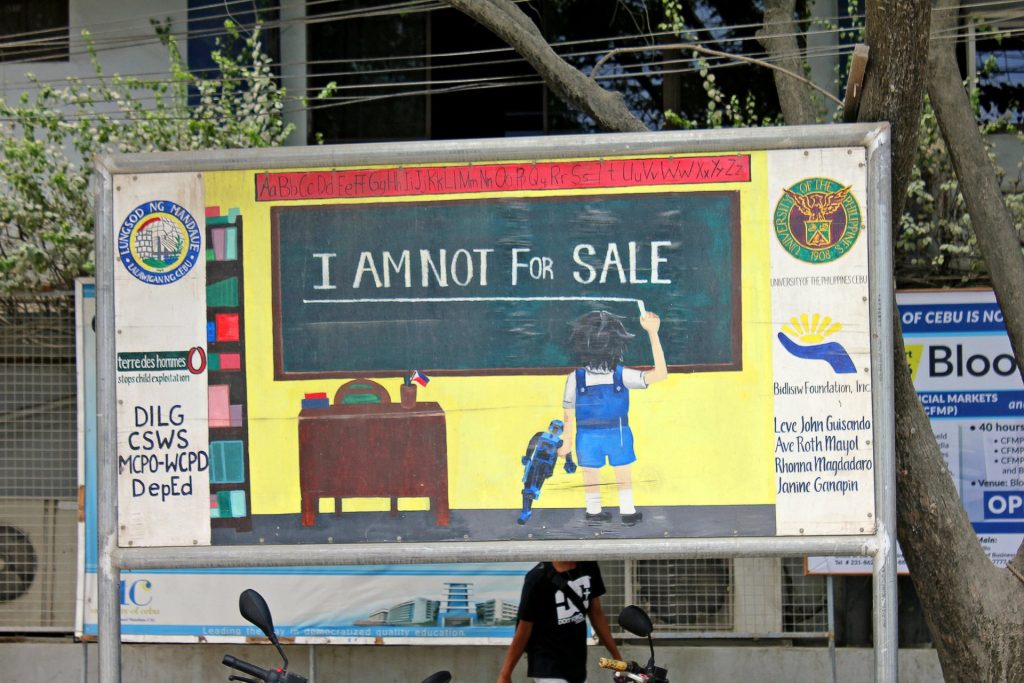When Philippine police smashed into the one-bedroom house, they found three girls aged 11, seven and three lying naked on a bed.
At the other end of the room stood the mother of two of the children – the third was her niece – and her eldest daughter, aged 13, who was typing on a keyboard. A live webcam feed on the computer screen showed the faces of three white men glaring out.
An undercover agent had infiltrated the impoverished village two weeks before the raid. Pretending to be a Japayuki, a slang term for a Filipina sex worker living in Japan, she had persuaded a resident to introduce her to the children, who played daily in the gravel streets.
Her guise was intended to put them at ease, to show them she worked in the same industry; she was one of them. She became close to the eldest, referred to as Nicole although that is not her real name. After a few days of chatting, Nicole causally told the agent about their “shows”.
“It was the first time we heard of parents using their children,” said the middle-aged woman.
Authorities considered that operation in 2011 to be a one-off case. But the next month, another family was caught in the same area. Then more cases of live-streaming child abuse appeared in different parts of the Philippines.
Now, the United Nations says, there are tens of thousands of children believed to be involved in a rapidly expanding local child abuse industry already worth US$1bn.
In some areas, entire communities live off the business, abetted by increasing internet speeds, advancing cameraphone technology, and growing ease of money transfers across borders.
And while perpetrators used to download photos and videos to their hard drives – providing authorities with a virtual paper trail and usable evidence – criminals have found anonymity in encrypted live-streaming programs.
International police agencies are mobilising. The Virtual Global Taskforce, a partnership of international law enforcement agencies and Interpol, has dedicated 2016 to combatting the live-streaming of child abuse.
Next month, Unicef will launch a campaign to educate young people about the risks of the online world. The UK’s #WeProtect project, an international alliance to fight online child abuse, has promised £10m to the campaign.

‘It is big money’
Stephanie McCourt, the south-east Asia liaison officer for the UK’s National Crime Agency, said the Philippines provided a perfect storm to allow the crime to develop, with its entrenched poverty and high level of internet access for a developing country. But there is one thing that she said was absolutely key: a widespread knowledge of the English language.
“They can communicate with offenders. After we’d been scratching our heads, the penny dropped,” she said. “That’s not to say that it won’t move to other countries … There is probably a huge amount we don’t know.”
It is hard to estimate the size of an industry involving small anonymous payments, roughly $5-$200 a show, conducted in people’s homes and mostly operated by families rather than large crime syndicates.
“We think that what we are seeing, what we are dealing with, is a small part of what is out there,” she said. “It is big money. Big business.”
Children are made to perform around the clock, with morning live-streams catering to Europeans and Americans, and later in the day, an Australian-based clientele.
The number of ongoing live-streaming criminal cases in the Philippines is rising, from 57 in 2013, growing to 89 in 2014, and up to 167 in 2015.
But those numbers belie the true scale, according to Det Supt Paul Hopkins, the head of the Australian Federal Police team in Manila who has spent the past two years investigating the crime. Wearing a short-sleeved, Filipino-style shirt, he described the size of the trade as “monstrous”.
One indication of how much is being missed is the number of “cybertips”, reports of sexual exploitation against children collected by the US-based National Center for Missing and Exploited Children (NCMEC). In 2015 alone, NCMEC forwarded nearly 15,000 tips to the Philippine Office of Cybercrime and 80% referred to the online exploitation of children. .
That is not to say the perpetrators are only based there. The Dutch NGO Terre des Hommes analysed the industry by constructing a virtual 10-year-old Filipino girl called “Sweetie” and used the computer model to entrap more than 1,000 adults who paid for her to perform sex acts. The charity identified adults from more than 71 countries seeking out Sweetie’s services.
Yet the business is nearly always immune to policing and almost never results in a conviction. In the Philippines, there have been only two convictions for this type of abuse. All other cases are still pending.
Unlike previous forms of child sexual abuse, there are no photos uploaded to the internet that police can track. Instead, the conversations are live and encrypted through Skype, and payment is made by anonymous wire transfers.
And while children have historically testified against sex traffickers in court, they have proved unwilling to incriminate their parents.
Children see abuse as normal
In the 2011 case, the police thought the children would welcome the operation. But the undercover agent says Nicole did not feel rescued; she felt betrayed.
“I know that she is angry with me,” the woman said.
Apart from the scene witnessed as the raid took place, police say they had a video showing the mother sexually abusing her children. It was submitted by an anonymous source from a western country who used his phone to film the abuse on his computer screen.
All six of the mother’s children – three boys and three girls – were moved to a rescue centre, a row of one-storey houses on a quiet path set back from the noise of the main roads. Trees surround the houses, and the staff have planted orchids by the path. In front of the children’s house is a small playground.
The day they arrived, the children played on the swings. Unlike others at the shelter, they showed no overt signs of abuse, their social worker explained. The staff, who had never dealt with a case like this before, wondered if they should be kept in the same shelter as other children who had been physically abused by paedophiles.

Photograph: Oliver Holmes for the Guardian
The children appeared oblivious to the fact that they had been exploited and it could affect them badly to realise they were abused like others around them.
The three-year-old continued to do “sexualised dancing” in front of other children, who complained to the staff.
“It was a struggle for the children to try to understand what their parents did,” said the social worker, sitting in the house where they live. “When one would start crying, the other children would collectively cry. They always converged in a small huddle.”
Directly after the arrest, the eldest boy, 16 at the time, did appear to be in shock, the psychologist Rosemarie Gonato said, but not from the abuse. “He was quite traumatised by the rescue operation.”
The two younger daughters had no idea that the abuse was anything but normal. “They said it was a business in the neighbourhood. It seemed natural to be involved in this as the other children were doing it,” she said. Police found that it was the children who first heard about live-streaming as a money maker when playing with their friends.
While the children have flourished – on the wall are photos of them, the two eldest beaming while wearing graduation hats and gowns – they are still unable, five years later, to understand the crime.
One child, now 14, told the Guardian her parents wanted the best for them. “I’d like to stay here and finish my course. Then I’d like to go home,” she said.
Gonato said: “In all the sessions I had [with the children], they still wanted their parents to get out of jail.” A couple of years after the raid, the children wrote a letter to Gonato, which read: “We hope you find the ability to forgive our parents.”
‘I accept that I have to suffer’
Five years after her arrest, and only a few miles from the family home, the mother of the children lives in the female quarters of a prison. Wearing a yellow T-shirt, blue eye makeup, lipstick and earrings, she gave birth to her seventh child behind bars. She denies the charges against her.
In her account, the children were naked as they were getting ready for a bath before school. Nicole was on Facebook, she said.
“I don’t think about the case. I have faith in God,” she said in the first interview since her detention. However, she added, “I accept that I have to suffer”.
Her two eldest children, including Nicole, have visited every Christmas and, last year, a judge allowed all six to come for the first time. “It was a joyful occasion,” she said, breaking in to tears in the small jail office where she is guarded by an officer. Money she earns through a prison work programme is sent to the children.

Photograph: Andy Brown/Unicef Philippines
Live-streaming has turned policing on its head. Interpol currently has an eight-step process to identify victims of child abuse, with step two being that the crime is documented by the abuser with photos and videos. Such documentation does not exist with live-streaming.
“When we see a money transfer from the Netherlands to the Philippines of €20, in court we might be able to prove it was for a webcam session. But the other side can say it was with an adult woman,” said the Dutch police attache in Manila, who asked to remain anonymous to comply with Netherlands police procedure.
Even when there is video evidence, such as in the 2011 case, the Philippines’ strong privacy laws make convictions hard to achieve.
The anti-wiretapping act means evidence collected from computers – even video footage of the abuse – cannot always be used in court. And a police offer can only get permission for a warrant if they have personal knowledge of the abuse.
This is why the undercover agent had to confirm that the parents were abusing their children.
Victims entangled in own abuse
On top of that, there are questions about whether a parental conviction is the best outcome for the victims. Both Gonato and the paediatrician who treated the children, Naomi Navarro-Poca, believe it is in the children’s interests to be reunited with their parents and live at home rather than in a shelter.
Even the prosecutor, who spoke to the Guardian on condition of anonymity to protect the identities of the children, said she was hoping for a plea bargain to get a reduced sentence.
“We really want reunification with the family,” she said, adding that the minimum sentence for the parents would be 12 years, with five already served. The youngest child would be eight when they were released. How the parents would be prevented from reoffending is not known.
A plea bargain rests on the mother admitting to the crime, a move the prosecutor said she hoped to achieve this year by asking Nicole to convince her mother. Yet cooperation with the children is proving frustratingly hard to achieve.
The social workers, doctors, police, legal team and psychologists working with the children initially assumed they were trying to protect their parents out of love. But it became apparent there were other reasons for them holding back, especially the eldest.
Several factors about the crime did not make sense. For one, the parents are unable to speak the level of English needed to communicate with perpetrators abroad, even though they are considered to be the instigators of the crimes.
And in therapy sessions, the eldest boy said their lives had changed for the better since they started the “shows”: the family had more money, they could eat at the local fast food chain Jollibee, and their mother could stop working in a factory.
Slowly, what had happened became apparent. “They saw the neighbours making money. They suggested it to their parents,” the prosecutor said. And at 13, it was Nicole who spoke to the paedophiles online, not her mother.
There were even times when the children did it without their parents present, the prosecutor said.
“It is such a sad story. Such a poor family needing money,” said Hopkins. “Mum was educated to grade one. This is the irony of it – the mother was just as vulnerable. The eldest daughter had a higher level of education.
“I’ve heard of other cases where the elder kids had very much been part of it. They need psychological support to know that it is wrong.”
While no blame can ever be attributed to children in these cases, the Philippines is struggling to understand how to punish crimes where the victims are deeply entangled in their own abuse, especially if parents are putting pressure on them to find an income.
“Children will do anything for their parents,” said Lotta Sylwander, the Unicef representative to the Philippines who is leading the online safety campaign.
“We need to raise awareness and vigilance of this issue, so that parents and others understand that child abuse – in any form – is not just morally wrong, it is also extremely harmful to children’s health and development.
“Unfortunately, at the moment the situation is getting worse, not better.”


2 Responses
Wow… This is quite unbelieveable. The world has become so corrupt and children are mostly the victims. May God help us and save us from this tragedy
This online child sexual abuse is as a result of poverty. Spending much money like $10m on campaign to fight against it, such money should be use in assisting them and also engage in things that can reduce this high poverty rate that leads them to this shameful act.